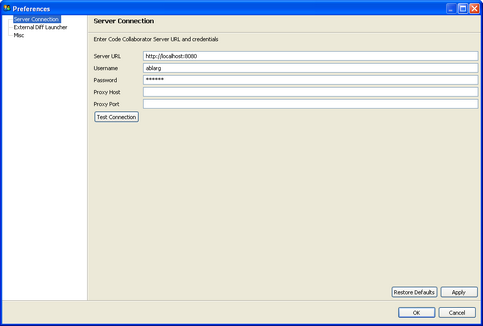If you used the graphical installer, your connection to the Code Collaborator Server should be configured already. Otherwise, you will be prompted when you try to connect.
The GUI Client, Command Line Client, Tray Notifier, and SCM Triggers share a common server connection configuration file. The server connection configuration can be set with a graphical interface using GUI Client or the Tray Notifier, or on the command-line using the Command Line Client.
Selecting File -> Preferences on the GUI Client main screen or selecting Preferences in the Tray Notifier context menu open the graphical Server Connection preferences page.

GUI Client Server Connection preferences
The Server URL must include the correct port number and path if applicable. The Username and Password are the same as you use when logging into the web server. The proxy settings should be used if you have a client proxy between your workstation and the server.
Use the Test Connection button to make sure the connection is working. If it fails, the error message will be helpful.
The Command Line Client uses the following global options to specify the connection to the Code Collaborator Server:
| • | url - URL to server (must be a valid, fully-specified URL) |
| • | user - Username (same as web user login) |
| • | password - Password (same as web user password) |
| • | server-proxy-host - URL of proxy server host name, if any |
| • | server-proxy-port - Port number to use on proxy server, if any |
Use the ccollab login command to connect to the Code Collaborator Server and save your server connection options to the configuration file.
You can try testing your configuration to verify the configuration is working.
Code Collaborator uses several configuration files to store configuration. When a user sets server connection configuration using the graphical interface or the command-line, the settings are stored inside a directory called .smartbear inside the user's home directory. (Under Windows, the "home directory" is your "Documents and Settings" Profile directory.)
The .smartbear directory and the configuration files therein can be placed in other locations to establish default behavior. Each of the locations is loaded in a particular order of precedence, with each successive location overriding the settings (if any) in the previous locations:
| 1. | INSTALLDIR/.smartbear Here INSTALLDIR refers to the Code Collaborator installation directory. This is typically /opt/ccollab-cmdline under Unix or C:\Program Files\Code Collaborator Client under Windows. This is most useful for system-wide default settings. |
| 2. | PROFILEDIR/.smartbear Here PROFILEDIR refers to a directory specified using the Java property smartbear.profile on one of the Code Collaborator Client executables. With this property defined, the client will look in this directory for more configuration. This is most useful for executable-specific default settings, such as settings just for SCM server-side triggers. |
| 3. | USERDIR/.smartbear Here USERDIR refers to the user's home directory (under Windows, your "Documents and Settings" Profile directory). This is the default location for configuration settings to be stored, and is useful for user-specific settings. |